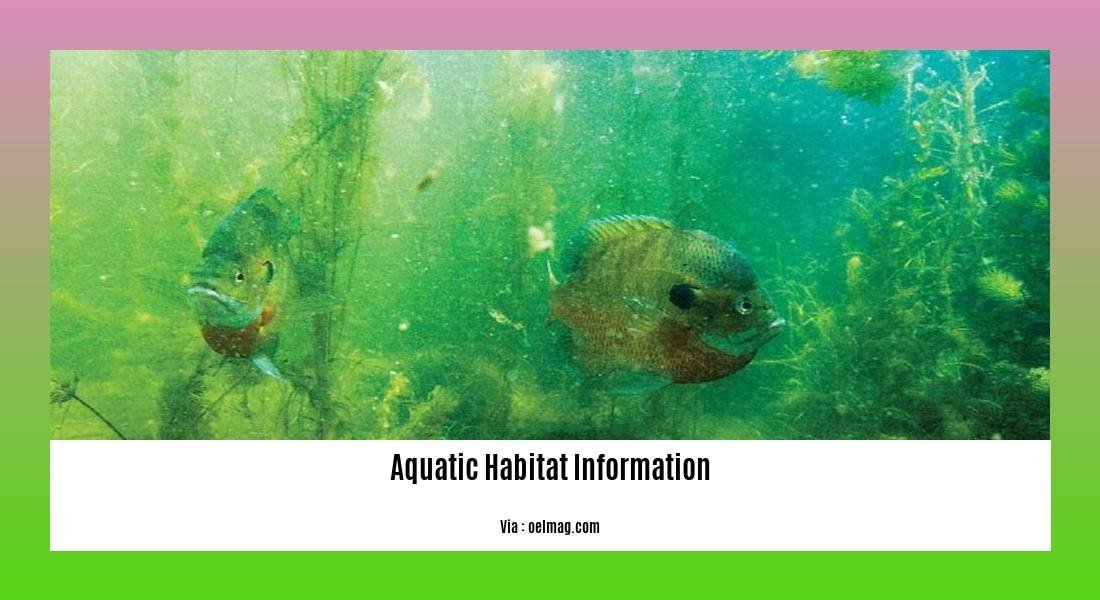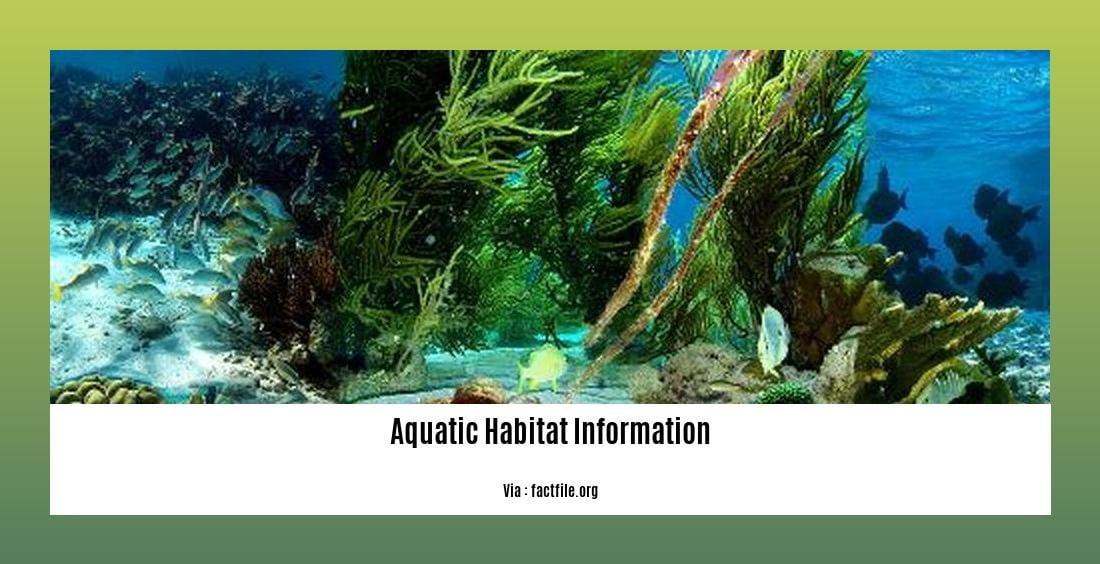Delve into the depths of aquatic habitats and discover a world teeming with life and intricacies. In “Beneath the Surface: Exploring Aquatic Habitat Information and the Importance of Preservation,” we embark on a journey to understand the various types of aquatic habitats, their significance, and how fish thrive within these watery realms. From the microscopic organisms to the larger marine life, we unravel the complex relationships and ecological dynamics that make these habitats truly fascinating. Join us as we shed light on the importance of preserving these fragile ecosystems for the benefit of present and future generations.
Key Takeaways:
- Aquatic habitats are places where water is present and support the life of aquatic organisms.
- These habitats can be natural or man-made and vary in size, salinity, and flow.
- Examples of aquatic habitats include oceans, lakes, ponds, rivers, streams, marshes, swamps, and coral reefs.
- Aquatic organisms can include animals, plants, and other living things that depend on water.
- Aquatic habitats can be classified as non-flowing waters, slowly flowing waters, or flowing waters.
- Aquatic habitats range in size from small puddles to oceans and support a wide variety of plant and animal life.
- Natural materials such as rocks, coral, gravel, sand, and mud contribute to defining aquatic habitats.
- Marine habitats and freshwater habitats are the two main types of aquatic habitats, each playing a vital role in maintaining different species’ populations.
- Aquatic habitats are important for ecological balance and the survival of aquatic species.
- Additional information on aquatic habitats can be found on specified websites.
Aquatic Habitat Information

The world beneath the water’s surface is teeming with life, with countless species relying on aquatic habitats for their survival. Understanding the intricacies of these habitats is crucial for their conservation and the preservation of our planet’s biodiversity. In this article, we will delve into the fascinating realm of aquatic habitat information, exploring the different types of aquatic habitats and their significance in maintaining thriving ecosystems.
Types of Aquatic Habitats
Aquatic habitats come in various forms, each with its own unique characteristics and inhabitants. Let’s take a closer look at some of the main types:
Oceans: The vast expanse of the world’s oceans is one of the most diverse and expansive aquatic habitats. From coral reefs to deep-sea trenches, oceans provide a home for an incredible array of marine life, including fish, marine mammals, and countless other organisms.
Lakes and Ponds: These bodies of still water host a wide range of aquatic organisms. Lakes tend to be larger and deeper, while ponds are smaller and shallower. They serve as crucial habitats for fish, amphibians, and waterfowl.
Rivers and Streams: These flowing water habitats are characterized by their constant movement. They support a rich diversity of species, including fish, insects, and various macroinvertebrates. Rivers and streams play a vital role in freshwater ecosystems, transporting nutrients and supporting intricate food webs.
Wetlands: Marshes, swamps, and other wetland habitats are areas where land and water meet. These transitional zones are incredibly productive and serve as breeding grounds for many species. Wetlands are known for their high biodiversity and provide essential ecological services, such as water purification and flood prevention.
Coral Reefs: These underwater marvels are home to a staggering variety of marine life. Coral reefs are built by tiny coral polyps and provide shelter and food for countless species. They are often referred to as the “rainforests of the sea” due to their high biodiversity.
Importance of Aquatic Habitat Preservation
Now that we have explored the different types of aquatic habitats, it is imperative to understand the importance of preserving them. Aquatic habitats are not only fascinating and beautiful but also play a crucial role in maintaining the balance of our planet’s ecosystems. Here are some key reasons why their preservation should be a priority:
Biodiversity Conservation: Aquatic habitats support an incredible array of species, many of which are found nowhere else on Earth. By preserving these habitats, we protect countless organisms and ensure the continuation of vital ecological processes.
Climate Regulation: Aquatic habitats, particularly oceans, play a significant role in regulating the Earth’s climate. They absorb and store vast amounts of carbon dioxide, helping mitigate the impacts of climate change. Additionally, coastal habitats like mangroves and salt marshes act as natural buffers against storm surges and coastal erosion.
Economic Benefits: Aquatic habitats contribute to the economy in various ways. They support industries such as tourism, fisheries, and aquaculture, providing livelihoods for millions of people worldwide. Preserving these habitats translates into sustainable economic growth and long-term benefits for communities.
Recreational Value: Many aquatic habitats provide opportunities for recreational activities such as snorkeling, scuba diving, boating, and fishing. Preserving these habitats ensures that future generations can continue to enjoy and appreciate the wonders of the underwater world.
In conclusion, understanding aquatic habitat information is essential for appreciating the delicate balance and intricate interactions within these ecosystems. By recognizing the significance of preserving aquatic habitats, we can become better stewards of our planet and work towards a sustainable future for both human and aquatic life. Let us embrace our responsibility to protect these fragile habitats, ensuring their continued existence for generations to come.
Table:
| Type of Aquatic Habitat | Main Characteristics |
| ———————– | ——————– |
| Oceans | Vast, diverse, and home to marine life of all sizes |
| Lakes and Ponds | Still bodies of water, hosting fish, amphibians, and waterfowl |
| Rivers and Streams | Flowing water habitats, vital for freshwater ecosystems |
| Wetlands | Transitional zones where land and water meet, supporting high biodiversity |
| Coral Reefs | Underwater structures built by coral polyps, providing a home for countless species |
Aquatic habitat information is abundant, but have you ever wondered if goldfish are good for ponds? Find out more about this topic by clicking here.
Dive into the question of whether lakes are safe to swim in and discover the answer by clicking here.
Curious about the consequences of having pond snails? Discover if they are bad for your pond by clicking here.
Importance Of Aquatic Habitat

6 Reasons Why Habitat Matters to Fish and People
Habitat serves as a vital component for the survival and well-being of fish and plays a key role in supporting human societies as well. Let’s dive deeper into the importance of aquatic habitat for both fish and people:
Providing Safe Neighborhoods for Young Fish
Aquatic habitat serves as a safe shelter and nursery for young fish, offering protection from predators and ensuring their survival. It provides a nurturing environment where young fish can grow and develop before venturing out into the open waters.
Acting as a Hiding Spot for Fish
Many fish species utilize aquatic habitat as a hiding spot, where they can seek refuge from predators and reduce their risk of being preyed upon. The intricate structure and features of the habitat offer numerous hiding places for fish, allowing them to stay safe and thrive.
Crucial for Mating
The location of aquatic habitat plays a vital role in the mating process of fish. It provides suitable conditions and resources required for successful reproduction. Various fish species rely on specific types of habitat for spawning and ensuring the continuation of their populations.
Facilitating the Movement of Fish
Aquatic habitat allows fish to follow their food sources, ensuring a steady supply of nutrition and promoting overall health and survival. Different habitats provide diverse food options, and their interconnectedness allows fish to migrate and explore new areas in search of sustenance.
Protecting Growing Families
Habitat provides a sheltered environment for fish to protect and raise their offspring. It offers a secure space where growing families can thrive, ensuring the survival and growth of future generations of fish.
Impacting Overall Well-being
The significance of aquatic habitat extends beyond fish; it affects the well-being of human beings as well. Healthy habitat supports sustainable fisheries, contributing to the availability of seafood for our food supply and boosting local economies. Preserving and protecting habitat ensures the long-term viability of fish populations and maintains the delicate balance of our ecosystems.
It is evident that the importance of aquatic habitat encompasses both fish and people. Protecting and preserving these habitats is essential to maintaining diverse and robust fish populations that contribute to the overall health of our ecosystems and the well-being of human societies.
Key Takeaways:
- Aquatic habitat plays a crucial role in the survival and well-being of fish, providing them with safe neighborhoods, hiding spots, and suitable conditions for mating.
- Habitat facilitates fish movement, allowing them to follow their food sources and ensuring a steady supply of nutrition.
- It also provides a sheltered environment for fish to protect and raise their offspring, ensuring the growth and survival of future generations.
- Aquatic habitat is not only important for fish but also impacts human societies by supporting sustainable fisheries and contributing to our food supply and economy.
- Preserving and protecting habitats is essential to maintain diverse fish populations and the delicate balance of our ecosystems.
References:
– NOAA. (n.d.). 6 Reasons Habitat Matters to Fish, and People Too. Retrieved from
– World Animal Foundation. (n.d.). Aquatic Habitat – All You Need To Know. Retrieved from https://worldanimalfoundation.org/advocate/wild-earth/params/p…
How Fish Use Aquatic Habitat
Aquatic habitats are essential ecosystems that provide a wide range of benefits for fish species. Understanding how fish use these habitats is crucial for their survival and for maintaining healthy aquatic ecosystems. In this article, we will explore the ways in which fish utilize their aquatic habitat, highlighting the importance of preserving these environments for the future.
Finding Shelter and Protection
One of the primary reasons fish seek out aquatic habitats is for shelter and protection. These habitats provide a safe haven where fish can hide from predators, seek refuge from extreme environmental conditions, and reduce the risk of being preyed upon. Whether it’s a submerged log, a rocky crevice, or dense vegetation, fish rely on these structures within their habitat to ensure their safety and survival.
Breeding Grounds for Fish
Aquatic habitats also serve as crucial breeding grounds for fish. Different species have specific requirements for successful reproduction, and they often choose specific habitats that provide the ideal conditions. For example, some fish species prefer spawning in calm, shallow waters with plenty of vegetation, while others may choose fast-flowing streams with gravel beds. These habitats offer the necessary resources, such as food availability and suitable water conditions, for successful reproduction and the survival of the offspring.
Habitat Preference for Different Species
It’s important to note that different fish species have distinct preferences when it comes to their habitat. Some species thrive in freshwater environments, while others are better suited to saltwater or brackish conditions. Furthermore, within each habitat type, fish have specific requirements for temperature, salinity, oxygen levels, and food availability. Understanding these preferences is crucial for effective management and conservation efforts to ensure the survival of diverse fish populations and the overall health of aquatic ecosystems.
The Role of Habitat in Fish Movement
Aquatic habitats play a vital role in facilitating the movement of fish. They provide a network of interconnected environments that allow fish to migrate, seek out food sources, and access suitable breeding grounds. For example, estuaries serve as transitional habitats where fish can navigate between freshwater rivers and the open ocean, capitalizing on the abundance of resources available in these areas. By preserving and maintaining these habitats, we can help ensure that fish populations can freely move and thrive within water ecosystems.
The Importance of Fish Habitat Preservation
Effective management and preservation of fish habitat are crucial for maintaining healthy aquatic ecosystems and sustainable fisheries. Protecting and restoring essential fish habitat not only safeguards fish populations but also helps to maintain productive fisheries and rebuild depleted fish stocks. By recognizing the vital role aquatic habitats play in the survival and reproduction of fish species, we can work towards implementing conservation measures that safeguard these fragile environments.
Key Takeaways:
– Aquatic habitats provide shelter and protection for fish, allowing them to hide from predators and reduce their risk of being preyed upon.
– These habitats serve as important breeding grounds for fish, with different species preferring specific conditions for successful reproduction.
– Fish habitat preference varies among species, with specific requirements for temperature, salinity, oxygen levels, and food availability.
– Aquatic habitats facilitate fish movement, allowing them to migrate, seek out food sources, and access suitable breeding grounds.
– Preservation and restoration of fish habitat are vital for maintaining healthy aquatic ecosystems, sustainable fisheries, and the overall balance of marine and freshwater environments.
Sources:
– Fish Habitat – Animals A to Z for Kids
– What is fish habitat? – Pêches et Océans Canada
FAQ
Q1: What is an aquatic habitat?
A1: An aquatic habitat is any place where water is the primary element and can range in size from small puddles to oceans. It supports a wide variety of plant and animal life, including fish, amphibians, reptiles, mammals, and birds.
Q2: What are the types of aquatic habitats?
A2: Aquatic habitats can include oceans, lakes, ponds, rivers, streams, marshes, swamps, and coral reefs. These habitats vary in size, salinity, and flow, providing different environments for aquatic organisms.
Q3: Why is aquatic habitat important?
A3: Aquatic habitats are vital for the survival and well-being of aquatic organisms, including fish. They provide safe neighborhoods for young fish, act as hiding spots, facilitate mating, allow movement to follow food sources, protect growing families, and impact overall well-being for both fish and humans. Healthy habitats also support sustainable fisheries and contribute to the overall health of ecosystems.
Q4: How do fish use aquatic habitat?
A4: Fish use aquatic habitats for shelter and protection from extreme environmental conditions. These habitats also serve as breeding grounds, where different species of fish prefer specific types of habitats for reproduction. Fish depend directly or indirectly on habitat for their life processes, making effective management and preservation of freshwater fish habitat essential for healthy aquatic ecosystems and sustainable fisheries.
Q5: What is the importance of preserving aquatic habitat?
A5: Preserving aquatic habitat is crucial to maintaining diverse and robust fish populations, which contribute to the overall health of ecosystems and the well-being of human societies. By protecting and restoring essential fish habitat, we can maintain productive fisheries, rebuild depleted fish stocks, and ensure the long-term sustainability of aquatic ecosystems.
















